| Pages:
1
..
31
32
33
34
35
..
68 |
gnitseretni
Hazard to Others
  
Posts: 280
Registered: 5-1-2007
Location: Medellin
Member Is Offline
Mood: No Mood
|
|
Quote: Originally posted by watson.fawkes  | | On the other hand, it might be more, because a small block might act like a thinner block, more flexible and getting out of the
way. |
Yeah, that's why I think penetration will be less in a bigger block. I believe the steel "getting out the way" decreases resistance, resulting in
increased penetration.
|
|
|
MrRedox602
Harmless

Posts: 7
Registered: 7-1-2012
Member Is Offline
Mood: No Mood
|
|
No cross-posting.
[Edited on 8-1-2012 by Ramiel]
"Any problem on Earth can be solved with the careful application of high explosives. The trick is not to be around when they go off." -Valkyrie
|
|
|
gnitseretni
Hazard to Others
  
Posts: 280
Registered: 5-1-2007
Location: Medellin
Member Is Offline
Mood: No Mood
|
|
Did another shaped charge. But it was a failure. Wasn't nearly as loud as it shoulda been. I think I know what happened. The detonator was too short,
too little stuck out underneath the 3/4" thick cap that I turned from MDF to center the detonator. I thought about turning a concave cavity on the
inside of the cap, but no.. numbnuts (me) was too impatient!! 
I'm quite pissed off at myself as I had high hopes for that beautiful shiny liner that I turned on my lathe to a uniform wall thickness of 0.95mm. And
now it's gone 
http://youtu.be/KXVbMwotE9g
|
|
|
Farnsworth
Harmless

Posts: 37
Registered: 11-5-2012
Member Is Offline
Mood: No Mood
|
|
Something I found fascinating in the "Brief History of Shaped Charges" text:
"Watson stated that the lined cavity effect required only one-fifth to one-sixth as
much explosive as an unlined booster, and the lined cavity charge would function
over a considerable air gap. This fuze was, in effect, a detonator using the shaped-
charge principle."
I'm surprised this didn't cause more of a stir. A method of articulating a detonator in a way that conserves a considerable amount of explosive
material (and its corresponding reagents).
Perhaps better suited to a different topic, but I think a discussion on the construction of low-volume caps utilizing this effect would have some
merit.
Sorry for making a jump-in for my first post. I'm a long-time lurker and was once an active poster over on RS. Physics is more my specialty than
chemistry, but damn if energetic materials don't tickle my pickle.
|
|
|
Hennig Brand
International Hazard
    
Posts: 1284
Registered: 7-6-2009
Member Is Offline
Mood: No Mood
|
|
Well here are a few pictures from a shaped charge experiment. Performance was nothing to brag about, but I learned a few things.
The liner was a 1.5" ID, 60 degree angle copper cone with ~2% CD wall thickness. Standoff was 1.5 times CD. Charge head height was only about 1 CD. If
I had more explosive prepared, 1.5 times CD or more for charge head height would have been better.
Charge was 114g of 16% inerts ETN platique, with a density of ~1.43g/cc. Initiation was accomplished with 1g PETN base charge, 0.3g lead azide and
basic lead picrate flash igniter in aluminum tube & ignited by fuse.
That small hole in the last steel piece actually goes more than half way through. Total penetration was ~1.88 inches or ~1.25 times CD. It is obvious
from inspection of the plates that the jet trifurcated, or split into three parts. Performance wasn't great, but several things were less than
optimal. The aluminum form, used to electroform the cone, was turned on an older lathe and the resultant cone was not symmetrical by quite a bit (I am
starting to realize just how important perfect symmetry is). The charge head height should have been larger for best results. The SC might have
performed better if the liner thickness was 3% CD instead of 2%.
I am going to find someone with a precise lathe to clean up my aluminum form.
BTW, each steel piece is 3/4" thick.
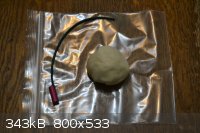 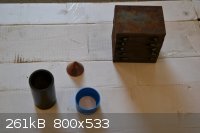 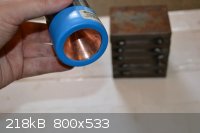
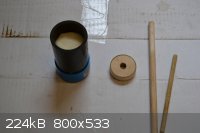 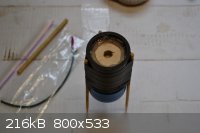 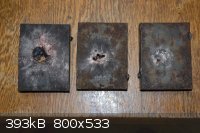
[Edited on 7-6-2012 by Hennig Brand]
"A risk-free world is a very dull world, one from which we are apt to learn little of consequence." -Geerat Vermeij
|
|
|
gnitseretni
Hazard to Others
  
Posts: 280
Registered: 5-1-2007
Location: Medellin
Member Is Offline
Mood: No Mood
|
|
Some improvements would be like you already said, thicker liner, more head height, perhaps increase standoff to 2 CD.
Also, that blue thingy.. It looks like it was made of plastic and I assume that was what held the liner in place? If so, no good. You want your liner
to sit on a strong edge that ain't going nowhere. Next time, cut a thin slice of the same diameter pipe you use for confinement and cut a little piece
out of the ring. Squeeze it together and place it inside the pipe and tack it in place. Make sure it's level otherwise your liner sits at an angle..
unless you're going to face it in the lathe then it won't matter.
Also, one reason I like to use liquid HE is because it has a perfect uniform density every single time. Making plastic HE at home, your density will
vary with each batch.
Just my 2cents. 
|
|
|
Hennig Brand
International Hazard
    
Posts: 1284
Registered: 7-6-2009
Member Is Offline
Mood: No Mood
|
|
Thanks for the feedback and I like your method of locking a cone into a steel pipe.
The black pipe in the picture is just black ABS 1.5 inch sewer pipe. That blue plastic cone holder was an ABS end cap that I drilled a centered hole
in leaving a lip for the cone base to sit on. ABS cement was used to glue the end cap (cone holder) to the pipe. I could upgrade to a heavier ABS end
cap for another dollar or so. The heavier end caps, in the plumbing section, looked to be about 3 times as thick as the one I used (about the same
thickness as the pipe).
You would probably advise against using plastic then. I assume you thought the black pipe was steel.
I am unsure how suitable the ETN plastique I am using is for shaped charges. It appears to be very brisant though which is a good sign. Uniform
density without effort is an area where the liquid high explosives have it over the plastiques, that is true. I may have to try a SC with a liquid
nitric ester, just for comparison purposes. As far as handling properties and safety goes though, plastic explosives are so much better.
edit:
Yeah, I guess I forgot to explain that the pipe was ABS in the above description. I thought it would be obvious, but now that I am looking at the
pictures I can see that it isn't.
[Edited on 7-6-2012 by Hennig Brand]
"A risk-free world is a very dull world, one from which we are apt to learn little of consequence." -Geerat Vermeij
|
|
|
gnitseretni
Hazard to Others
  
Posts: 280
Registered: 5-1-2007
Location: Medellin
Member Is Offline
Mood: No Mood
|
|
Oops, yeah I thought it was steel. Was kinda wondering why you'd use a steel pipe and then hold the liner in place with something made of plastic 
I don't advise against plastic. I'd say use whatever material is easiest for you to work with. Perhaps not the best advise from a safety standpoint.

|
|
|
Farnsworth
Harmless

Posts: 37
Registered: 11-5-2012
Member Is Offline
Mood: No Mood
|
|
I was doing some Googling concerning shaped charge patents earlier today and stumbled across a discussion on another site related to military
applications.
It's an imageboard, so foul language warning. The TC gets a few minor points wrong, but he does go into some excellent detail and cites sources.
http://www.operatorchan.org/k/res/17785.html
Bonus points because two of them talk about this place.
|
|
|
Fulmen
International Hazard
    
Posts: 1693
Registered: 24-9-2005
Member Is Offline
Mood: Bored
|
|
Need some feedback on liner shape, I'm working on deep draw fabrication of conical liners. I've already made a die to draw 0.5mm copper disks down to
a 15mm OD x 10mm cup, next is deciding on the final shape. I could go for a straight cone ending in a 2mm radii, but a funnel would probably be easier
to get right. If I can draw it down enough I could end up with a 4mm OD stem, 10mm long and with a 2mm radius at the top, wouldn't this be a better
design than a straight cone?
|
|
|
pyro10%school0%
Harmless

Posts: 3
Registered: 24-11-2012
Member Is Offline
Mood: No Mood
|
|
could i use coke tin/aluminium can to make a shaped charge bottom of that have something like a plate...
|
|
|
CaliusOptimus
Hazard to Self
 
Posts: 96
Registered: 10-6-2011
Member Is Offline
Mood: Subjectively Objective
|
|
Check out this shaped charge I found on the tube:
http://www.youtube.com/watch?v=QlTFBvsSijU
|
|
|
franklyn
International Hazard
    
Posts: 3026
Registered: 30-5-2006
Location: Da Big Apple
Member Is Offline
Mood: No Mood
|
|
That is a very good example of improvisation.
Observing closely the interior of the liner one can see a soldered seam.
It is apparent that the cone is a rolled up pie section of a circular piece
of sheet metal , likely around 120 degrees. This serves to show that
one need not be all that fancy to form copper for the liner.
_______________________________________________
Steel Cutting with High Explosive Charges
www.dtic.mil/dtic/tr/fulltext/u2/479244.pdf
Explosive Forming of Metals
www.dtic.mil/dtic/tr/fulltext/u2/605372.pdf
Method for Calculating the Initial Fragment Velocities from Hollow Warheads
www.dtic.mil/dtic/tr/fulltext/u2/441810.pdf
.
|
|
|
franklyn
International Hazard
    
Posts: 3026
Registered: 30-5-2006
Location: Da Big Apple
Member Is Offline
Mood: No Mood
|
|
This is just cool.
Consider that the jet of a shaped charge will be ten time faster
than the high velocity rounds seen here. The way the soft lead
splats against hard armor is the same way the shaped charge
jet does but because of the higher pressure it generates , it
pushes through the armor in the same way that the armor
piercing rounds do also seen here. The gelatin shots show the
effect of cavitation produced on elastic medium at high velocity.
1 million frames per second slow motion video of bullet impacts
www.youtube.com/watch?v=QfFoMyMoiX4
84mm Carl Gustav HEAT 751 shaped charge tamdem warhead
www.youtube.com/watch?v=q6j9wEF1sf8
the follow on charge passes through the hole made first by the
shaped charge. Except for size this is essentially a Durandal fired
sideways. => www.youtube.com/watch?v=_m-buvo3dj4
www.sciencemadness.org/talk/viewthread.php?tid=12885#pid1633...
.
|
|
|
gnitseretni
Hazard to Others
  
Posts: 280
Registered: 5-1-2007
Location: Medellin
Member Is Offline
Mood: No Mood
|
|
Another failed SC. Like the third one in a row or something. Pretty frustrating! 
2.3mm thick walled, 1.5" diameter, 60 degree electroformed copper cone. Yeah, pretty thick liner.
Aluminum container, 2" ID, 2-1/4" OD.. so 1/8" thick walls. Height of container about 6".
Standoff was 6" (4CD). This charge had subcalibration. Walls off container were 1/4" from base of liner.
HE used was methyl nitrate/nitromethane (25/75 % by volume).
Target: 4 mild steel plates stacked together, bottom 3 plates were 2" thick and top plate was 1-1/2" thick, so total of 7-1/2".
Not sure why this SC failed. I wonder if I didn't get full detonation. It could be that I didn't mix the MN with the NM well because shaking it was a
little nerve wrecking so maybe I shook it a little too careful  Or maybe they
separated in two layers (MN is heavier after all). Time between mixing and detonation was probably about 5 mins. Or maybe they
separated in two layers (MN is heavier after all). Time between mixing and detonation was probably about 5 mins.
The explosion sounded a little different than usual as well. It wasn't a sharp crack, it was more like ANNM, a gutsy boom.
Looking at the top plate you can see the charge included subcalibration. There's a nice round pattern around the hole left by the jet, not the other
much wider hole. And it's odd there are two holes. One was clearly produced by the jet because the copper slug is still in it and there's shiny pink
copper all over, but the walls of the other hole, which is much wider and just as deep if not deeper, is not lined by shiny pink copper.. it's lined
with a color that looks a hell of a lot like brass. I once melted some aluminum and mixed in a little bit of copper. When cooled it looked like brass,
just like this. So I'm guessing it was mostly aluminum with a tiny bit of copper from the liner mixed in that made the wide hole.
I went through quite a bit of trouble trying to make sure everything was as symmetrical as possible because I've been trying to improve on the 6-1/4"
penetration I got a while ago. I thought the thick liner would perform great with the added subcalibration.
I won't go through this trouble again. The SC that penetrated 6-1/4" was everything BUT symmetrical. The container was thin walled stainless steel off
round tubing. The liner was electroformed on an off round fence cap. The container however was fairly tall (a lot of head height), I wonder if that
was why it performed so well. Actually penetration was only like 3 and a 1/4 CD or something which really isn't that impressive, but considering how
far from perfect everything else about the charge was, I'd say it did pretty well.
That was my last electroformed copper. These liners do work but they take so long to make. I'll give the rubber pad forming process a try in the
future.
Video: http://youtu.be/DbTA-MNA-kc
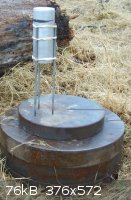 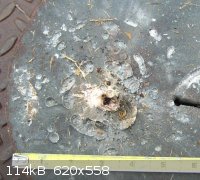 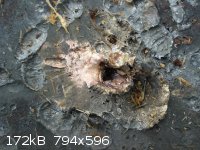 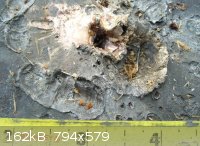 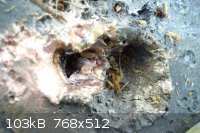
[Edited on 12-28-2012 by gnitseretni]
|
|
|
gnitseretni
Hazard to Others
  
Posts: 280
Registered: 5-1-2007
Location: Medellin
Member Is Offline
Mood: No Mood
|
|
Did a heck of a lot of reading up on shaped charges since yesterday. Went through lots of PDFs, one in which they confirmed what I suspected why that
one charge that penetrated 6-1/4" did so well compared to the others.. lots of head height. Without the use of a waveshaper, in order to get a
stable/flat wave before it reaches the cone is by increasing head height. I'm pretty sure this is why my previous SC's failed. I'm not sure if lack of
head height was the only thing to blame for my last SC failure though. At least in my other SCs I used pure PGDN. In my last SC I used methyl nitrate
mixed with nitromethane. Maybe the gap in VOD between these two screwed up the wave. But hell I don't know, and probably never will, unless I find a
source that says otherwise. Best to use just one HE (no mixtures), and a liquid one at that, so density is always the same which leaves one less
variable to worry about.
Another source mentioned the varies ways SC liners are manufactured commercially. I think I'll stick to electroforming liners as apparently
electroformed liners have potential for being excellent performers. The key to a good liner, other than the obvious ones such as the right wall
thickness, perfect symmetry, etc.. is small grain size. The smaller the grain size, the longer the jet can stretch without breaking up. This is why
electroforming is a great way to make liners as you can get an extremely small grain size, as opposed to, for example, cones turned from a solid
copper rod which have a large grain size. Cones produced by metal spinning are supposed to be heat treated to relieve stresses in the cone. IIRC, I
think it said 30 mins at 500C. It didn't say what to do with it afterwords, quench it or let it cool slowly. Then again, they were talking about
liners produced by the metal spinning process in general, no mention of types of metal or anything. Quenching copper in water does not work harden it,
but that doesn't go for all metals. On the other hand I don't think it matters. Not for copper anyway, I found a PDF where they tested annealed copper
liners vs non-annealed liners and there was no difference.
Ways to improve penetration that I have found so far is by using waveshapers and trumpet shaped liners over conical shaped liners. However, trumpet
shaped liners are less forgiving to imperfections than cone shaped liners. With trumpet shaped liners, the top of the liner is cylindrical (or near
cylindrical) as opposed to a sharp point with cone shaped liners. As Axt has already demonstrated, no standoff is required with cylindrical liners as
the jet is already formed when it reaches the bottom of the charge. The trumpet shaped liner is like a hydrid between a conical and cylindrical liner.
The cylindrical part of the trumpet shaped liner is to increase jet tip velocity to increase penetration. Increasing jet tip velocity also stretches
the jet further than is possible with conical liners and this increased stretching of the jet is why trumpet shaped liners are less forgiving to
imperfections in the liners. A trumpet shape btw is just a modified cone. You can get increased penetration using conical shaped liners by for example
using two different slopes (steeper slope towards apex). Steeper slope means faster jet tip velocity.
Anyways, I guess I'm just kind of summarizing some of the things I've read over the last 1-2 days. Thought I'd post it to both help me remember for
later and in case there are still others experimenting with shaped charges. Are there?
|
|
|
PHILOU Zrealone
International Hazard
    
Posts: 2893
Registered: 20-5-2002
Location: Brussel
Member Is Offline
Mood: Bis-diazo-dinitro-hydroquinonic
|
|
Gnitseretni,
I didn't knew you question about mixing methyl nitrate and nitromethane was to make shaped charges.
I think that both are too slow detonating HE to make shaped charges.
http://en.wikipedia.org/wiki/Shaped_charge
Small apex angle is sometimes responsible of bifurcation.
The speed of sound in copper liner is arround 3,9 km/s.
Wikipedia states that MN is arround 8 km/s VOD but this is wrong ... in reality it is 6,3 km/s and NM is in the same range!
In the cavity this speed is slowered and is probably too close to the liner speed of sound (3,9 km/s)...
Usually to make shaped charges one need to get high VOD HE like RDX (over 8 km/s) or HMX (over 9 km/s).
I remember that usually one must be over 7 km/s HE to be able to cut steel with a shaped charge.
Also in your movie arround 8/9 seconds one can see that the upper blast is directed to the left and forms an angle of 30° with the vertical. This may
come from the cutted tree on the side or from an inherent unstability/unsymetry.
Could it come from the detonator?
I suspect that if the detonator is not strictly vertical (parallel to the shaped charge axis) then detonation can behave like it did in your
detonation.
What was the HE in your detonator? Where and how was it placed... Your photos don't show the detonator.
PH Z (PHILOU Zrealone)
"Physic is all what never works; Chemistry is all what stinks and explodes!"-"Life that deadly disease, sexually transmitted."(W.Allen)
|
|
|
gnitseretni
Hazard to Others
  
Posts: 280
Registered: 5-1-2007
Location: Medellin
Member Is Offline
Mood: No Mood
|
|
Hmm... I thought MN was comparable to NG in power and VOD.
I turned the container on my lathe as well as the top that held the detonator perfectly centered and vertical. (Detonator was NHN with ETN base with
nichrome wire embedded in NHN and fired remotely) I turned the copper cone down as well. When it was done plating, I chucked the cone form with the
copper cone still on, in my 3 jaw chuck. I'll admit I didn't check for runout with my dial indicator. If there was any runout it would have resulted
in non uniform wall thickness and I only checked the wall thickness on one side.
I got a little in a hurry in the end. I wanted to use MN only, but got impatient and added NM.
After all the research I did after this SC, I realized that the liner was probably way too thick, plus I didn't use enough head height. Add to that
the poor choice of HE and it's no surprise the SC was a failure. I'll stick to PGDN from now on. It has proven to work just fine for SC's.
|
|
|
VladimirLem
Hazard to Others
  
Posts: 204
Registered: 24-5-2010
Member Is Offline
Mood: Have no fear <Vlad> is here.
|
|
the explosive would work at a glass-liner...
AND the liner is MUCH to thick walled...1.5mm walled would be maximum, even with HEs like PETN...0.8-1.0mm will work fine with etn or similar stuff
[Edited on 3-1-2013 by VladimirLem]
[Edited on 3-1-2013 by VladimirLem]
|
|
|
franklyn
International Hazard
    
Posts: 3026
Registered: 30-5-2006
Location: Da Big Apple
Member Is Offline
Mood: No Mood
|
|
Improvised Shaped Charges with Plastic Explosive Filler
www.dtic.mil/dtic/tr/fulltext/u2/283016.pdf
.
|
|
|
NeonPulse
Hazard to Others
  
Posts: 417
Registered: 29-6-2013
Location: The other end of the internet.
Member Is Offline
Mood: Isolated from Reality! For Real this time....
|
|
Wine bottle bottoms as liners.
i was wondering if anyone else has tried the bottoms of wine bottles as a liner? I thought that they may be too thick but after testing one to see for
myself, the results were OK. so i used 225g ANNM but in fairly weak confinement- a high pressure plastic gas pipe. The liner was epoxied in place.the
target was 4 6mm structural steel plates stacked up, and i gave it minimal standoff of 1.5 cone diameter and was very surprised at how well this
liner performed. A nice round 25mm hole and 30mm deep. The first two plates had full penetration and the others dented fairly hard. There was also a
rather large plug of highly compressed powdered glass that was slightly fused by pressure and heat i suspect. These plugs were very hard. A lot harder
than the actual glass it was made from and almost like stone. Took a while to clear them out to see the damage.. All up i would say the cone did well
and i will be testing another one or two very soon but this time using stronger confinement and greater standoff distance.
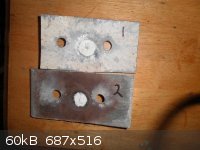
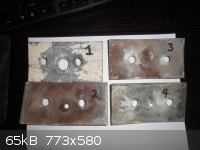 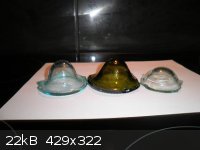
|
|
|
Melmoth
Harmless

Posts: 28
Registered: 15-7-2002
Location: The Netherlands
Member Is Offline
Mood: No Mood
|
|
| Quote: |
Explosively loaded champagne bottles and other conical
based bottles for demolition and special applications is very
well known and commonly taught for military use. It is
believed that such practice dated to a period of improvised
munitions used early in World War II
|
Attachment: Glass as a shaped charge liner material1.part1.rar (1.4MB)
This file has been downloaded 575 times
Attachment: Glass as a shaped charge liner material1.part2.rar (760kB)
This file has been downloaded 546 times
"This species has amused itself to death"
|
|
|
SherlockHolmes
Harmless

Posts: 44
Registered: 29-7-2012
Location: Bulgaria
Member Is Offline
Mood: No Mood
|
|
I also tried to do a shaped charge but did not work. Any idea why? http://www.youtube.com/watch?v=jU3TIpoMQN4
Sorry for my english. I am not from England. Thank you!
|
|
|
VladimirLem
Hazard to Others
  
Posts: 204
Registered: 24-5-2010
Member Is Offline
Mood: Have no fear <Vlad> is here.
|
|
hm...hard to say...at first, you took some test tube as the detonator cap....im not sure if this is the best choice...for ignition of ANFO or other
normal explosive devices it will work good, but at a shaped charge it can/could be that the detonation wave does not move straight to the apex (hard
to describe :/ ) there is simply to many surface where the detonation can start....a thick walled tube, with extreme thin bottom would be better, so
that you can bet, that theres the point, the detonation in the main charge starts...
other possible factors could be the liner....datas? (wallthickness, diameter...) what about the head-hight (distance from INI to top of cone - seems
to short)...
the explosive seems optimal (powerfull/fast enough) for this job...
---
edit:
another other reason could be, that your selfmade liner where soldered and the liner colapsed at this weak part without forming a jet....
[Edited on 19-10-2013 by VladimirLem]
|
|
|
Pard
Harmless

Posts: 38
Registered: 29-11-2013
Member Is Offline
Mood: No Mood
|
|
Quote: Originally posted by NeonPulse  | i was wondering if anyone else has tried the bottoms of wine bottles as a liner? I thought that they may be too thick but after testing one to see for
myself, the results were OK. so i used 225g ANNM but in fairly weak confinement- a high pressure plastic gas pipe. The liner was epoxied in place.the
target was 4 6mm structural steel plates stacked up, and i gave it minimal standoff of 1.5 cone diameter and was very surprised at how well this
liner performed. A nice round 25mm hole and 30mm deep. The first two plates had full penetration and the others dented fairly hard. There was also a
rather large plug of highly compressed powdered glass that was slightly fused by pressure and heat i suspect. These plugs were very hard. A lot harder
than the actual glass it was made from and almost like stone. Took a while to clear them out to see the damage.. All up i would say the cone did well
and i will be testing another one or two very soon but this time using stronger confinement and greater standoff distance.
|
Why to use just the bottoms? I've seen before to use the whole bottle without the neck. Like wine bottles. Is it better using just conical bottom?
By the way, how do you guys design your copper cones? I thought about maybe going to metal work place to ask to do it. It is a strange request but I'm
sure they would. It's not like they'd realise what it is for.
|
|
|
| Pages:
1
..
31
32
33
34
35
..
68 |